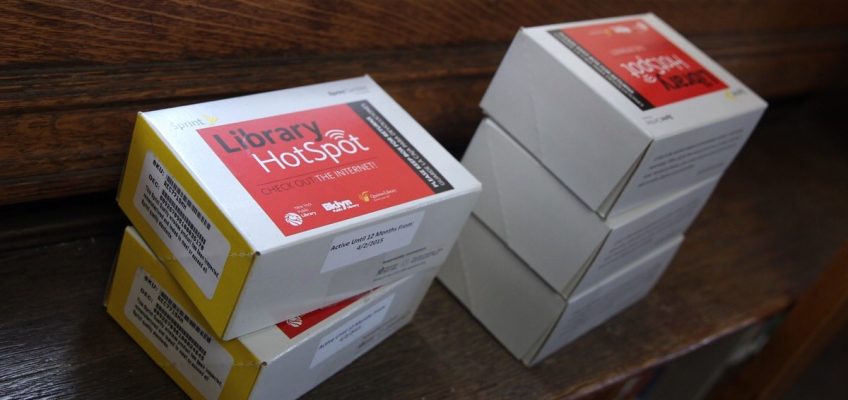“Every step we need to take to get out of the shelter system involves using the internet to access resources, apply for jobs, and submit rental applications. You might think shelters would provide us with a Wi-Fi connection. You’d be wrong.”
Wi-Fi hotspots. (William Alatriste for the New York City Council)
How many times today have you used the internet? Maybe you sent an email, found directions, paid for the subway, or talked to a doctor? In 2025, the internet isn’t a luxury—it’s how we access our everyday lives.
The internet may feel universal, but not everyone enjoys equal access. While the New York City Council and state government have worked to expand internet access, people living in the New York City shelter system, like us, are still left out. Every step we need to take to get out of the shelter system involves using the internet to access resources, apply for jobs, and submit rental applications. You might think shelters would provide us with a Wi-Fi connection. You’d be wrong.
Last month, the New York City Council passed a requirement for the city to develop an Internet Master Plan to achieve low-cost access to broadband internet in homes throughout the city. But what about the hundreds of thousands of people, like us, who don’t have homes? People sleep every night in shelters that don’t provide internet connectivity. The city’s omission of our needs is a glaring disservice at a moment when New York’s homelessness crisis is only getting worse.
When you’re choosing between groceries and a cellular plan, personal internet access isn’t a given—and that makes rebuilding your life nearly impossible. Finding a job, submitting housing applications, communicating with legal services, or applying for benefits all require going online. So do telehealth appointments, online coursework, and banking/managing bills: all of which are important resources for a stable life.
Coalition for the Homeless estimates that 40 percent of shelters for adults lack Wi-Fi, based on data collected from its monitoring of the Department of Homeless Services shelter system. Without Wi-Fi, people experiencing homelessness are forced to travel and pay for insecure public networks unsuitable for telehealth or legal matters.
VOCAL-NY and Takeroot Justice surveyed the shelter system to understand how homeless New Yorkers access the internet, and the findings from their “Wi-Fi for All” report were disheartening. Only 30 percent of surveyed single-adult shelters had computer rooms, and nearly 80 percent of those included restrictions such as time limits, too few machines, restricted hours, and privacy concerns. In shelters that do provide Wi-Fi, 80 percent of those attempting to access it on their personal devices reported issues, including a slow/inconsistent network, limited coverage areas, outages, and monitoring concerns.
When people who live in shelters are not able to reliably access the internet, the consequences can be devastating. Of those surveyed in Wi-Fi for All, a lack of internet access caused 53 percent to lose housing opportunities, 48 percent to miss job opportunities, 30 percent to experience healthcare disruptions, and 16 percent to miss court dates. Lack of access can be isolating, preventing communication with friends and family, or life-threatening for those who rely on medical devices that require an internet connection, like heart monitors.
The problem isn’t limited to the city. Gov. Kathy Hochul has invested more than $1 billion to transform the state’s digital infrastructure and expand access to reliable, affordable high-speed internet through the ConnectAll program. Although the program notes that providing Wi-Fi in shelters and homeless service facilities is critical for connecting people who do not have access to a home broadband connection, shelters have been left out of the funding equation. This discrepancy is a major injustice to the thousands of people like us who live in shelters. State lawmakers should respond by passing A1755/S8026, which would guarantee statewide Wi-Fi in temporary housing using the ConnectAll funding stream.
The consequences of limited internet access for an already vulnerable population are severe—and entirely avoidable. Both the City’s Internet Master Plan and the State’s ConnectAll program fail to address the needs of people living in shelters throughout our state, creating barriers for people like us to exit homelessness.
New York must act to require building-wide internet in every shelter, with minimum speeds for video and uploads, access in rooms and common areas, and privacy protections. Bringing Wi-Fi into shelters isn’t just about connecting people to the web—it’s about opening pathways out of homelessness for the people who need it the most.
Troy Walker is a member of the Coalition for the Homeless Client Advisory Group. Reynaldo Medina is a member of VOCAL-NY’s Homelessness Union.
The post Opinion: Wi-Fi Isn’t a Luxury appeared first on City Limits.


Leave a Reply